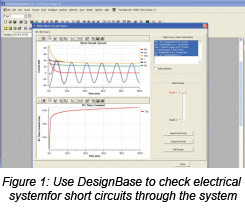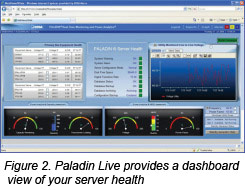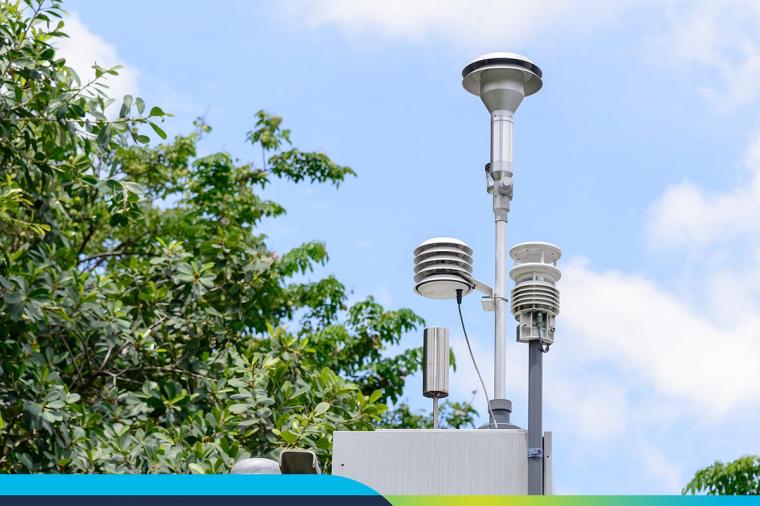Power Analytics: An Electrifying New Approach to Operations Management
Unless you are involved in building or facilities management, few designers encounter, or are required to support, post-build issues such as power cuts, or suffer the associated productivity and economic losses that power cuts can cause. [acronym] online’s, Vinny Poliseno, talked to Mark Ascolese of EDSA about making power systems “perfect on paper” before a single building foundation is laid.
 People familiar with AutoCAD Revit for building information modeling (BIM) applications know it’s the premiere platform for architectural engineering and construction. But as magnificent as the resulting structures are, they are very much like the skeletal system in the human body – a physical framework throughout which other vital systems like HVAC, plumbing, and electrical power – must be threaded.
Like building a ship in a bottle, incorporating all of these separate systems into a single structure involves extensive planning, beginning from the outset of the design phase, and frequently relying on specialized design, analysis and simulation software tools.
This is particularly important in modern “power-centric” facilities with extraordinary mission-critical requirements, e.g. data centers, customer service offices, law enforcement operations, transportation and air traffic control facilities, and military installations, where the loss of electrical power also results in the loss of vital services or capabilities.
“Not many facility operators realize that 40 percent of all their functional downtime is caused by electrical power problems, and that 80 percent of those problems originate within their facility, not externally,” said Mark A. Ascolese, Chairman & CEO of EDSA, a power systems software developer in San Diego, CA. “Electrical power problems cause $150 billion in downtime and damages every year and, in the public sector, they can have catastrophic consequences.”
To help organizations maintain high levels of electrical power reliability – while at the same time lower their energy consumption – EDSA developed Paladin, its proprietary power analytics software platform.
As Ascolese explains, Paladin supports two very important tasks, described below.
Design and Test Power Systems
EDSA’s CAD modeling program – Paladin DesignBase – enables enables power systems engineers to meticulously design – and rigorously test – proposed power systems models in the design phase. This early testing ensures it will withstand the rigors of the live environment, while also performing as energy-efficiently as possible.
People familiar with AutoCAD Revit for building information modeling (BIM) applications know it’s the premiere platform for architectural engineering and construction. But as magnificent as the resulting structures are, they are very much like the skeletal system in the human body – a physical framework throughout which other vital systems like HVAC, plumbing, and electrical power – must be threaded.
Like building a ship in a bottle, incorporating all of these separate systems into a single structure involves extensive planning, beginning from the outset of the design phase, and frequently relying on specialized design, analysis and simulation software tools.
This is particularly important in modern “power-centric” facilities with extraordinary mission-critical requirements, e.g. data centers, customer service offices, law enforcement operations, transportation and air traffic control facilities, and military installations, where the loss of electrical power also results in the loss of vital services or capabilities.
“Not many facility operators realize that 40 percent of all their functional downtime is caused by electrical power problems, and that 80 percent of those problems originate within their facility, not externally,” said Mark A. Ascolese, Chairman & CEO of EDSA, a power systems software developer in San Diego, CA. “Electrical power problems cause $150 billion in downtime and damages every year and, in the public sector, they can have catastrophic consequences.”
To help organizations maintain high levels of electrical power reliability – while at the same time lower their energy consumption – EDSA developed Paladin, its proprietary power analytics software platform.
As Ascolese explains, Paladin supports two very important tasks, described below.
Design and Test Power Systems
EDSA’s CAD modeling program – Paladin DesignBase – enables enables power systems engineers to meticulously design – and rigorously test – proposed power systems models in the design phase. This early testing ensures it will withstand the rigors of the live environment, while also performing as energy-efficiently as possible.
 Actual vs. As-Designed
The online counterpart to DesignBase – Paladin Live – continually compares the specifications in the DesignBase model to the corresponding readings in the live environment; if any readings deviate from their as-designed specifications, the system assesses and isolates the anomaly – typically, before it can become a larger problem.
“Though it sounds technical, the concept of power analytics is really no different than a football coach designing new plays, running them in practice and then using them with confidence in a live game situation,” Ascolese explained. “In our case, we make sure the power system is perfect on paper before construction of the physical facility. After construction, when the facility goes live, there should be absolutely no surprises, if the CAD model was adhered to correctly.”
How powerful of a capability is this model-based approach? Well, compare it to using AutoCAD® to design an automobile braking assembly: with model-based capabilities, not only would AutoCAD’s solid modeling and finite-element analysis capabilities ensure optimally designed components at the end of the design phase, but, once installed in an automobile, it would provide real-time reports on wear-and-tear, future service needs and emerging safety threats.
Ascolese continued, “When you stop to consider how reliant some of our customers are on their electrical power infrastructure to continue operations – the FAA is responsible for the safety of 760 million passengers per year, and one data center customer alone processes $4 trillion in transactions per year – it is easy to see how an investment in this technology pays for itself very quickly.”
Actual vs. As-Designed
The online counterpart to DesignBase – Paladin Live – continually compares the specifications in the DesignBase model to the corresponding readings in the live environment; if any readings deviate from their as-designed specifications, the system assesses and isolates the anomaly – typically, before it can become a larger problem.
“Though it sounds technical, the concept of power analytics is really no different than a football coach designing new plays, running them in practice and then using them with confidence in a live game situation,” Ascolese explained. “In our case, we make sure the power system is perfect on paper before construction of the physical facility. After construction, when the facility goes live, there should be absolutely no surprises, if the CAD model was adhered to correctly.”
How powerful of a capability is this model-based approach? Well, compare it to using AutoCAD® to design an automobile braking assembly: with model-based capabilities, not only would AutoCAD’s solid modeling and finite-element analysis capabilities ensure optimally designed components at the end of the design phase, but, once installed in an automobile, it would provide real-time reports on wear-and-tear, future service needs and emerging safety threats.
Ascolese continued, “When you stop to consider how reliant some of our customers are on their electrical power infrastructure to continue operations – the FAA is responsible for the safety of 760 million passengers per year, and one data center customer alone processes $4 trillion in transactions per year – it is easy to see how an investment in this technology pays for itself very quickly.”
 But beyond just averting infrequent crises, the Paladin power analytics software platform delivers day-to-day benefits as well, especially in the area of energy savings and investment protection. Electrical infrastructure – and the electricity-consuming equipment throughout it, like computers, communications equipment, etc. – deteriorates over time due to wear-and-tear, dust and other environmental conditions.
Tracking the impact of that degradation can provide important clues about what equipment should be replaced and at what point. Like a tune-up for a car, power analytics system ensures that all systems are operating optimally, ensuring that energy is being used as efficiently as possible, and in turn, lowering energy costs.
Taking the car analogy a step further, Ascolese explained, “It’s like asking someone, ’What’s more important: having an airbag in your car, or getting high MPG?’ when we all know the truth is both. It’s nice to save a few thousand dollars a year in fuel costs but, when you’re in a head-on collision, that airbag is a lifesaver.”
Paladin’s power analytics system is proven in some of the world’s most demanding customer environments, protecting more than $100 billion in customer assets. Ascolese noted that – for new facilities that are still on the drawing board, or old structures in need of modernization – power analytics can provide three essential benefits.
But beyond just averting infrequent crises, the Paladin power analytics software platform delivers day-to-day benefits as well, especially in the area of energy savings and investment protection. Electrical infrastructure – and the electricity-consuming equipment throughout it, like computers, communications equipment, etc. – deteriorates over time due to wear-and-tear, dust and other environmental conditions.
Tracking the impact of that degradation can provide important clues about what equipment should be replaced and at what point. Like a tune-up for a car, power analytics system ensures that all systems are operating optimally, ensuring that energy is being used as efficiently as possible, and in turn, lowering energy costs.
Taking the car analogy a step further, Ascolese explained, “It’s like asking someone, ’What’s more important: having an airbag in your car, or getting high MPG?’ when we all know the truth is both. It’s nice to save a few thousand dollars a year in fuel costs but, when you’re in a head-on collision, that airbag is a lifesaver.”
Paladin’s power analytics system is proven in some of the world’s most demanding customer environments, protecting more than $100 billion in customer assets. Ascolese noted that – for new facilities that are still on the drawing board, or old structures in need of modernization – power analytics can provide three essential benefits.
 People familiar with AutoCAD Revit for building information modeling (BIM) applications know it’s the premiere platform for architectural engineering and construction. But as magnificent as the resulting structures are, they are very much like the skeletal system in the human body – a physical framework throughout which other vital systems like HVAC, plumbing, and electrical power – must be threaded.
Like building a ship in a bottle, incorporating all of these separate systems into a single structure involves extensive planning, beginning from the outset of the design phase, and frequently relying on specialized design, analysis and simulation software tools.
This is particularly important in modern “power-centric” facilities with extraordinary mission-critical requirements, e.g. data centers, customer service offices, law enforcement operations, transportation and air traffic control facilities, and military installations, where the loss of electrical power also results in the loss of vital services or capabilities.
“Not many facility operators realize that 40 percent of all their functional downtime is caused by electrical power problems, and that 80 percent of those problems originate within their facility, not externally,” said Mark A. Ascolese, Chairman & CEO of EDSA, a power systems software developer in San Diego, CA. “Electrical power problems cause $150 billion in downtime and damages every year and, in the public sector, they can have catastrophic consequences.”
To help organizations maintain high levels of electrical power reliability – while at the same time lower their energy consumption – EDSA developed Paladin, its proprietary power analytics software platform.
As Ascolese explains, Paladin supports two very important tasks, described below.
Design and Test Power Systems
EDSA’s CAD modeling program – Paladin DesignBase – enables enables power systems engineers to meticulously design – and rigorously test – proposed power systems models in the design phase. This early testing ensures it will withstand the rigors of the live environment, while also performing as energy-efficiently as possible.
People familiar with AutoCAD Revit for building information modeling (BIM) applications know it’s the premiere platform for architectural engineering and construction. But as magnificent as the resulting structures are, they are very much like the skeletal system in the human body – a physical framework throughout which other vital systems like HVAC, plumbing, and electrical power – must be threaded.
Like building a ship in a bottle, incorporating all of these separate systems into a single structure involves extensive planning, beginning from the outset of the design phase, and frequently relying on specialized design, analysis and simulation software tools.
This is particularly important in modern “power-centric” facilities with extraordinary mission-critical requirements, e.g. data centers, customer service offices, law enforcement operations, transportation and air traffic control facilities, and military installations, where the loss of electrical power also results in the loss of vital services or capabilities.
“Not many facility operators realize that 40 percent of all their functional downtime is caused by electrical power problems, and that 80 percent of those problems originate within their facility, not externally,” said Mark A. Ascolese, Chairman & CEO of EDSA, a power systems software developer in San Diego, CA. “Electrical power problems cause $150 billion in downtime and damages every year and, in the public sector, they can have catastrophic consequences.”
To help organizations maintain high levels of electrical power reliability – while at the same time lower their energy consumption – EDSA developed Paladin, its proprietary power analytics software platform.
As Ascolese explains, Paladin supports two very important tasks, described below.
Design and Test Power Systems
EDSA’s CAD modeling program – Paladin DesignBase – enables enables power systems engineers to meticulously design – and rigorously test – proposed power systems models in the design phase. This early testing ensures it will withstand the rigors of the live environment, while also performing as energy-efficiently as possible.
 Actual vs. As-Designed
The online counterpart to DesignBase – Paladin Live – continually compares the specifications in the DesignBase model to the corresponding readings in the live environment; if any readings deviate from their as-designed specifications, the system assesses and isolates the anomaly – typically, before it can become a larger problem.
“Though it sounds technical, the concept of power analytics is really no different than a football coach designing new plays, running them in practice and then using them with confidence in a live game situation,” Ascolese explained. “In our case, we make sure the power system is perfect on paper before construction of the physical facility. After construction, when the facility goes live, there should be absolutely no surprises, if the CAD model was adhered to correctly.”
How powerful of a capability is this model-based approach? Well, compare it to using AutoCAD® to design an automobile braking assembly: with model-based capabilities, not only would AutoCAD’s solid modeling and finite-element analysis capabilities ensure optimally designed components at the end of the design phase, but, once installed in an automobile, it would provide real-time reports on wear-and-tear, future service needs and emerging safety threats.
Ascolese continued, “When you stop to consider how reliant some of our customers are on their electrical power infrastructure to continue operations – the FAA is responsible for the safety of 760 million passengers per year, and one data center customer alone processes $4 trillion in transactions per year – it is easy to see how an investment in this technology pays for itself very quickly.”
Actual vs. As-Designed
The online counterpart to DesignBase – Paladin Live – continually compares the specifications in the DesignBase model to the corresponding readings in the live environment; if any readings deviate from their as-designed specifications, the system assesses and isolates the anomaly – typically, before it can become a larger problem.
“Though it sounds technical, the concept of power analytics is really no different than a football coach designing new plays, running them in practice and then using them with confidence in a live game situation,” Ascolese explained. “In our case, we make sure the power system is perfect on paper before construction of the physical facility. After construction, when the facility goes live, there should be absolutely no surprises, if the CAD model was adhered to correctly.”
How powerful of a capability is this model-based approach? Well, compare it to using AutoCAD® to design an automobile braking assembly: with model-based capabilities, not only would AutoCAD’s solid modeling and finite-element analysis capabilities ensure optimally designed components at the end of the design phase, but, once installed in an automobile, it would provide real-time reports on wear-and-tear, future service needs and emerging safety threats.
Ascolese continued, “When you stop to consider how reliant some of our customers are on their electrical power infrastructure to continue operations – the FAA is responsible for the safety of 760 million passengers per year, and one data center customer alone processes $4 trillion in transactions per year – it is easy to see how an investment in this technology pays for itself very quickly.”
 But beyond just averting infrequent crises, the Paladin power analytics software platform delivers day-to-day benefits as well, especially in the area of energy savings and investment protection. Electrical infrastructure – and the electricity-consuming equipment throughout it, like computers, communications equipment, etc. – deteriorates over time due to wear-and-tear, dust and other environmental conditions.
Tracking the impact of that degradation can provide important clues about what equipment should be replaced and at what point. Like a tune-up for a car, power analytics system ensures that all systems are operating optimally, ensuring that energy is being used as efficiently as possible, and in turn, lowering energy costs.
Taking the car analogy a step further, Ascolese explained, “It’s like asking someone, ’What’s more important: having an airbag in your car, or getting high MPG?’ when we all know the truth is both. It’s nice to save a few thousand dollars a year in fuel costs but, when you’re in a head-on collision, that airbag is a lifesaver.”
Paladin’s power analytics system is proven in some of the world’s most demanding customer environments, protecting more than $100 billion in customer assets. Ascolese noted that – for new facilities that are still on the drawing board, or old structures in need of modernization – power analytics can provide three essential benefits.
But beyond just averting infrequent crises, the Paladin power analytics software platform delivers day-to-day benefits as well, especially in the area of energy savings and investment protection. Electrical infrastructure – and the electricity-consuming equipment throughout it, like computers, communications equipment, etc. – deteriorates over time due to wear-and-tear, dust and other environmental conditions.
Tracking the impact of that degradation can provide important clues about what equipment should be replaced and at what point. Like a tune-up for a car, power analytics system ensures that all systems are operating optimally, ensuring that energy is being used as efficiently as possible, and in turn, lowering energy costs.
Taking the car analogy a step further, Ascolese explained, “It’s like asking someone, ’What’s more important: having an airbag in your car, or getting high MPG?’ when we all know the truth is both. It’s nice to save a few thousand dollars a year in fuel costs but, when you’re in a head-on collision, that airbag is a lifesaver.”
Paladin’s power analytics system is proven in some of the world’s most demanding customer environments, protecting more than $100 billion in customer assets. Ascolese noted that – for new facilities that are still on the drawing board, or old structures in need of modernization – power analytics can provide three essential benefits.
- Increasing Reliability – 80% of electrical power problems are internal in nature, caused by gradual overloading, power quality problems or voltage irregularities, such power spikes and surges that damage delicate computer equipment.
- Understanding Capacity – This enables facility operators to make insightful decisions about equipment, environmental systems and other loads on their electrical system to maximize their investment in existing infrastructure.
- Reducing Energy Costs – President Bush’s “Energy Independence Act” of 2002 requires federal building tenants to reduce their energy usage to 50 percent of 2002 levels before 2012. But most government offices lack even the means to measure and analyze their energy usage, let alone reduce it. By revealing hidden clues buried deep in their power infrastructure, power analytics system helps facility operators see – and test – where opportunities for energy savings lie.

















































